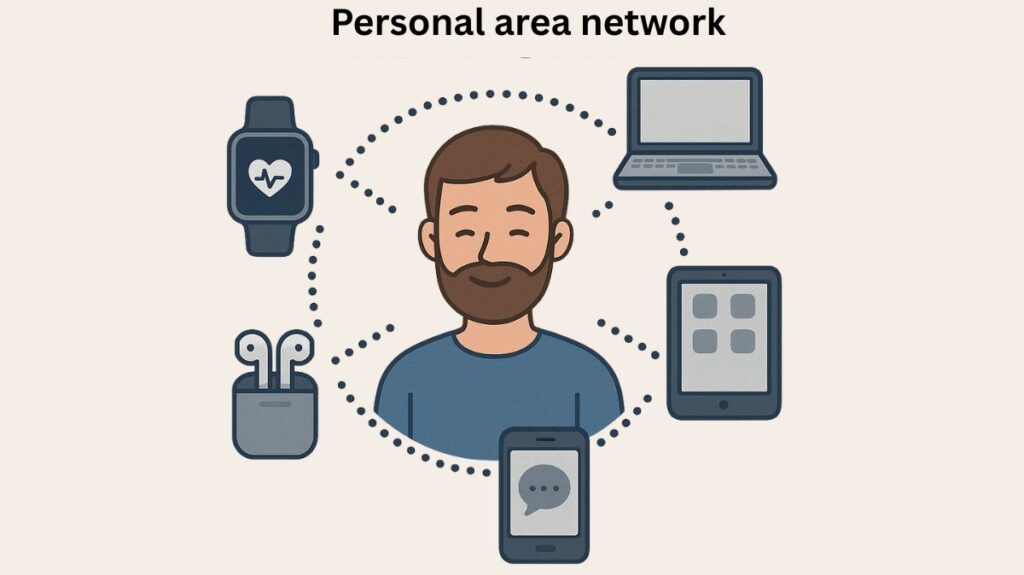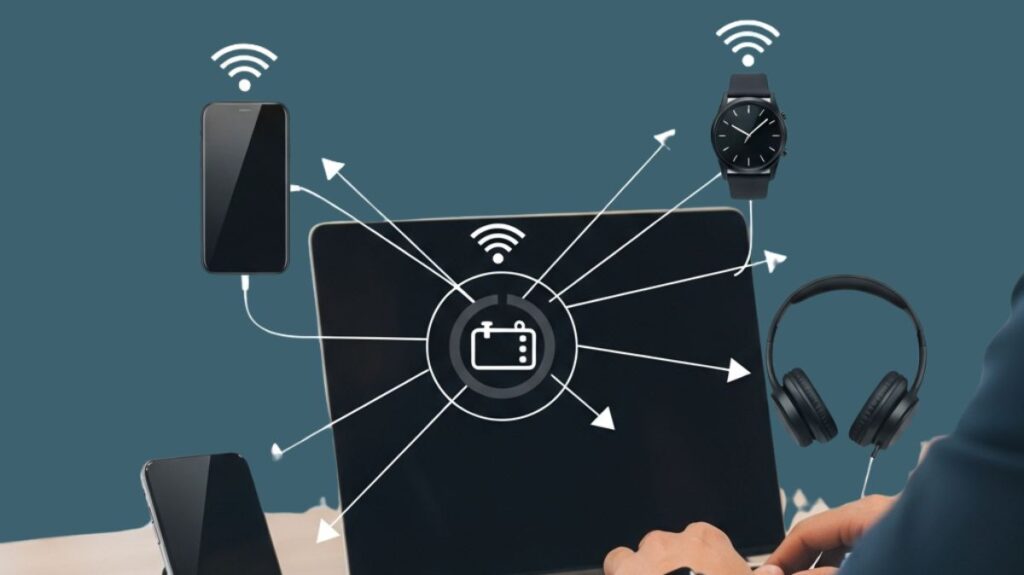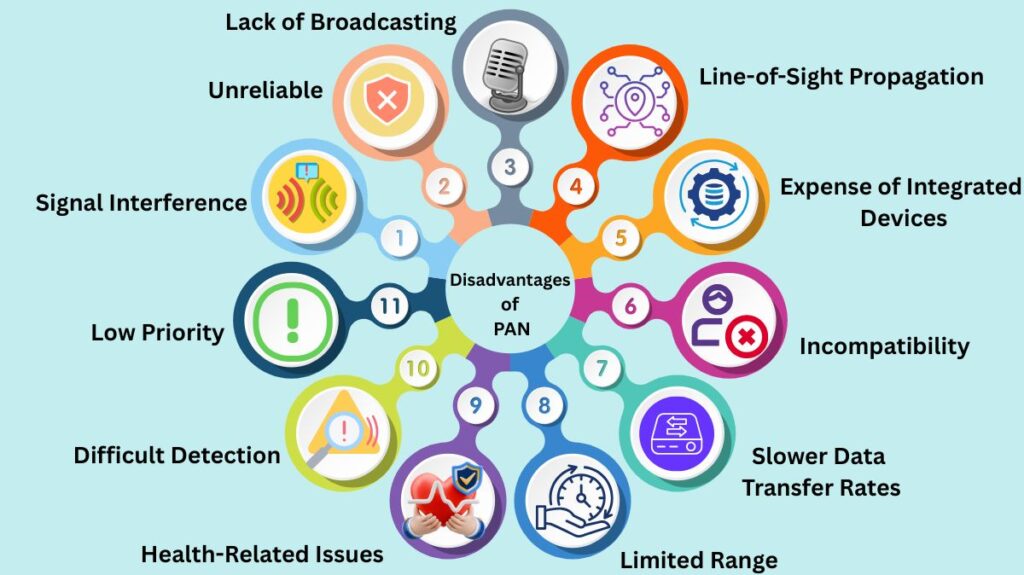The definition, history, how it work, features, types, advantages, disadvantages of personal area networks, as well as examples, applications, and the distinctions between PAN, LAN, and WAN, are all covered in this article.
PAN Personal area network definition

A personal area network, or PAN, is a small-scale computer network that allows devices within a certain radius of a person to communicate with one another. Usually a few meters, this range is frequently stated as being within 10 meters (33 feet). Data exchange between devices is one of the main personal work uses for PANs.
History of PANs
Thomas Zimmerman and colleagues at M.I.T.’s Media Lab were the first to conceive the idea of a Personal Area Network. In 1989, Ericsson Mobile created the Bluetooth WPAN standard, which at the time was referred to as “short-link” radio technology, for wireless headphone connectivity. When Intel repurposed it for computer-to-cell phone communication in 1997, it was renamed Bluetooth. Since its approval in 2010, Bluetooth 4.0 (Bluetooth Smart) with low energy (LE) has been widely used in the home automation and health/wellness sectors.
Also Read About Data Communication And Networking Technologies Protocols
How does Personal Area Network work

The operation of a personal area network (with an emphasis on Bluetooth):
Devices using Bluetooth technology must have a certain microprocessor that doubles as a short-range walkie-talkie. This microchip detects other Bluetooth-enabled devices by sending short-range radio signals in the 2.4 GHz range (2.402 to 2.480 GHz). After detection, the devices start talking to each other and sharing information. An ad hoc network called a “piconet,” which consists of one master device and up to seven active slave devices, can be formed by Bluetooth devices. Bluetooth employs radio communication, therefore it does not require a direct line of sight between devices like IrDA requires.
Personal area network features
Important PAN attributes and features include:
- PANs with a limited range typically function within a 10-meter radius.
- Individual Use They connect devices in a person’s immediate area or workstation and are meant for individual use.
- Wireless or Wired PANs can be set up using wired connections like USB or wireless technology like Bluetooth.
- Connection File sharing, peripheral control, and other features are made possible by their facilitation of communication and data exchange across devices.
- Low Power and Cost-Effective PANs are an economical method of connecting devices since they use less power.
- Auto-configurable and simple to use Compared to Local Area Networks (LANs), they are simpler to set up since they are user-friendly and enable devices to connect automatically without the need for human configuration.
- Synchronization of Data Data synchronization between linked devices is simple.
- Versatility PANs are utilized in a wide range of devices, including as smart TVs, printers, Bluetooth headsets, and AC remote controls.
- Not Always Linked to the Internet Basic device interaction does not require Internet connectivity, even if a PAN can link to a larger network, such as a LAN, to access the Internet.
Personal Area Network Types
Based on how they link, PANs can be divided into two primary types:
WPAN, or wireless PAN
The most prevalent form is this one. WPANs use signals like these to wirelessly connect devices:
- Bluetooth is a popular wireless technology that uses short-range radio waves. Its average range is 10 meters, but under the right circumstances, it can reach up to 100 meters. With Bluetooth, a single master device can connect to up to seven active slave devices in “piconets” fashion. Through information relaying, Bluetooth mesh networking can increase device counts and range.
- The Infrared Data Association (IrDA) facilitates line-of-sight, short-range communication by using infrared light. Device alignment is necessary for communication.
- ZigBee: A short-range, low-power technology frequently utilised in telemetry applications.
- Over PAN-type ranges, ultra wideband (UWB) can be employed for extremely high data rates.
Also Read About What Is A CISCO Company? Check Cisco Certification Levels
Wired PAN
Wires or cables are used to link these. Among the examples are:
- USB (Universal Serial Bus): A popular cable connection used to link peripherals such as external hard drives, printers, keyboards, and mice.
- Another wired interface for quick connections between peripherals is FireWire (IEEE 1394).
- A hardware interface that facilitates brief connections is called Thunderbolt.
Personal area network examples
Typical devices in a PAN include:
- Tablets, computers, and smartphones.
- Scanners and printers.
- Wireless headphones/earbuds, mice, and keyboards.
- Wearable technology, such as fitness trackers, smartwatches, and smart apparel.
- Personal Digital Assistants, or PDAs.
- Entertainment equipment like TV remote controls, video game consoles, and speakers.
Applications of PANs
Home and Offices (SOHO)
Because of its great flexibility and efficiency, SOHO is very helpful for personal work in both home and office environments.
Body Area Networks (BAN)
Mobile networks that follow a person about, such Bluetooth headphones and smartphones, or the medical sensors that are implanted in the body to track vital signs.
Offline Networks
Several devices linked via Bluetooth or Wi-Fi without utilizing the Internet, such as speakers, printers, and mice in a home connected to a computer.
Organizations
PANs are used for localized communication in the business and organisation sector, the medical and hospital sector, the school and college education sector, and the military and defence sector.
Advantages and Disadvantages of personal area network
Advantages of personal area network
Security
For the devices linked to the network, security is the most crucial characteristic. Compared to other wired networks like Ethernet, personal area networks are more secure. The devices that are connected to the network use or transmit data encrypted by the Personal Area Network. To prevent attacks or disruptions from any other party outside the network, all devices wishing to send data within the network must first obtain permission from the authorized party.
Cost-effective
There are no extra data fees for Internet use within the network, and devices connect via radio frequency (Bluetooth or Wi-Fi), eliminating the need for connections or wires.
Synchronisation
Simple data synchronisation for uploading, downloading, and sharing between linked devices.
Simple to Use
With automatic device connections and distinct IP addresses for identification, this system is easy to use.
Versatile
Suitable for a range of devices, including smart TVs, printers, and Bluetooth headsets.
Auto-Configuration
In contrast to LANs, devices can be added automatically without requiring manual configuration, making setup simpler.
Portability
Wireless PANs provide great portability by enabling devices to travel freely without being constrained by cables.
Stability and Dependability
Because they function within a constrained range and are not reliant on servers, they are more stable and dependable than networks with a wider reach.
Reduced Power Consumption
Portable devices benefit greatly from low-power wireless PANs, which use less energy.
Disadvantages of personal area network

Lack of Broadcasting: This is a significant disadvantage since it prevents all linked devices from receiving the same message at the same time, which makes them inappropriate for large applications involving numerous devices or great distances.
Unreliable (in comparison to WANs): Wide Area Networks (WANs) are more reliable than them since reliability and data transmission are dependent on radio frequency quality and device distance.
Signal Interference: When data is transmitted over Bluetooth or infrared radiation, it may interfere with other surrounding signals, disrupting communication and perhaps causing data loss.
Low Priority: Because of their restricted range, this network is regarded as having low priority compared to others.
Difficult Detection/Determination: Determining the device sizes, data flow rates, and total network size in PANs can be difficult.
Health-Related Issues: Because PANs are wireless networks, they release radiation (such as microwave frequencies) that can be dangerous to both people and animals, possibly leading to illnesses of the heart and brain.
Limited Range: For long-distance data sharing, the small range is a major drawback.
Slower Data Transfer Rates: Because Bluetooth and other technologies are unable to send huge amounts of data quickly, data transfer rates may be slower than those of bigger networks.
Incompatibility: It’s possible that devices won’t work with one another.
Expense of Integrated Devices: Integrated wireless PAN (WPAN) devices may be costly.
Line-of-Sight Propagation (for IrDA): Like a TV remote, IrDA-based PANs need a direct line of sight to communicate.
Also Read About What A Network Is And What Are Benefits Of Networking
Differences Between PAN, LAN, and WAN
Scope/Range
- PAN: Focused on a single individual, very short range, usually within 10 meters.
- Devices within a single room, building, or across buildings (like a university campus) are connected by a local area network, or LAN.
- Wide Area Networks, or WANs, cover larger service areas, like a city or the entire world (like the Internet).
Data Exchange/Speed
- PAN: Made for low-bandwidth applications, it can support speeds ranging from 24 Mbps (Bluetooth) to 250 kbps (Zigbee).
- LAN: Made to transfer data at high speeds, ranging from Mbps to Gbps (10, 100, 1000 Mbps, 10 Gbps, 40 Gbps, etc.).
- WAN: Maximum-rate systems that use fibre optics or gigabit Ethernet to transport data at speeds ranging from 1 to 40 Gbps.
Goal/Oversight
- PAN: Fully owned and operated by an individual, it connects personal devices for communication, data transmission, or Internet access. utilized for inter-system data links or low-data-rate home automation.
- LAN: Uses connected connections for faster and more secure connectivity, connecting devices at a single location to share resources and data.
- WAN: Serves as a regional backbone, connecting clients over whole cities or the entire globe.
Internet Connectivity
- PAN: Devices in a PAN can connect to a LAN, which in turn links to the Internet, but PANs usually do not have routers and cannot connect directly to the Internet.
- LAN: Capable of being linked to the web.
| Feature | LAN (Local Area Network) | MAN (Metropolitan Area Network) | WAN (Wide Area Network) |
| Geographic Area | Small (e.g., home, office building) | Moderate (e.g., city, large campus) | Large (e.g., country, continent) |
| Speed | Very High | High | Lower than LAN/MAN |
| Ownership | Private (by the organization/individual) | Public or Private | Public or Private |
| Example | A network in a single office | A network connecting all government buildings in a city | The Internet or a corporation’s global network |
Setting Up and Securing a Personal Area Network
Setup
Needs a communication channel (wired or wireless) and a minimum of two computing machines. Make sure both devices have Bluetooth enabled for wireless. On Windows, this entails choosing options to send or receive files after navigating through settings to add devices.
Security
PANs are vulnerable to threats such as Bluesnarfing (data theft over Bluetooth), location privacy breaches (tracking via Bluetooth transmissions), and weaknesses in Internet of Things devices.
- Countermeasures: To secure a PAN, users should minimize Bluesnarfing attacks (never accept unexpected pairing requests, require user consent for connections, pair new devices in private environments), protect against IoT vulnerabilities (use reputable manufacturers, update default passwords, use distinct complex passwords, create separate networks for IoT devices), and ensure location privacy (use the latest version of Bluetooth, keep software updated, enable location services only when needed The distance between devices determines security.
